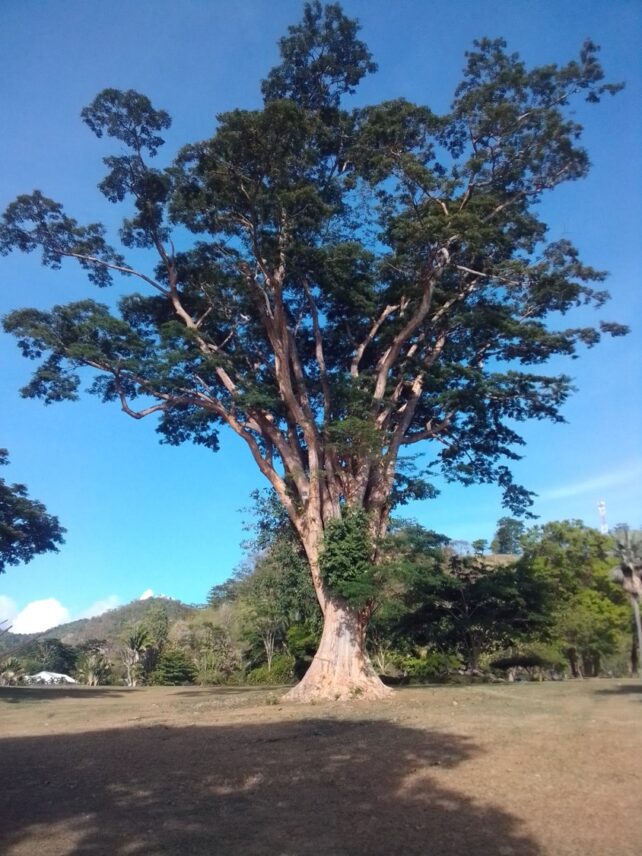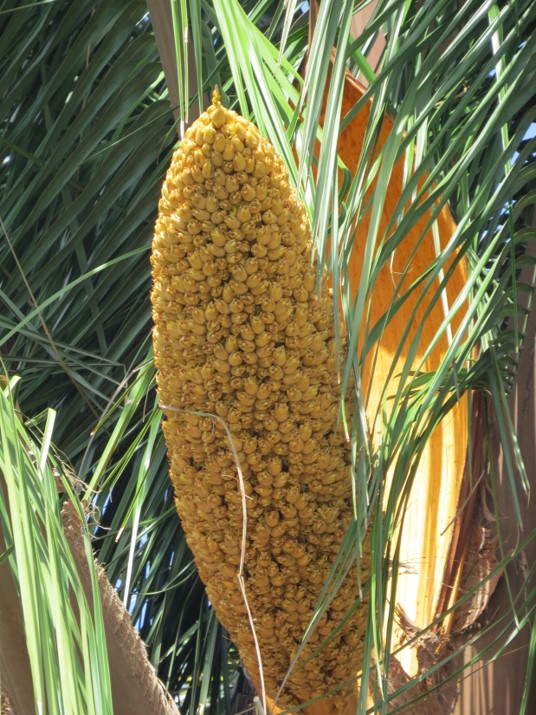
Part II of the article presented on the following trees: Guiana Chestnut, Indian Almond, Cannon Ball, Pink Poui, Ditta Bark, American Oil Palm and Teak. The article concludes below.
- SAMAAN (Samaneasaman):Just before Hurricane Maria there were 7 large Samaan Trees in the Gardens’ tree collection. Only two were left standing after the storm, one to the east and the other to the south-west of the Pavilion, while the others were all uprooted or toppled. One of the toppled trees, located to the south of the Main Lawn /cricket field, displayed some remarkable recovery, even after the harvestable timber had been salvaged from its limbs. That tree has since produced several branches that provide some much-needed shade, and is regularly used by members of WaituCirque – a group of young persons who are involved in joggling, acrobatics, etc.

After the lumber was salvaged from the fallen tree, the stump assumed an angular orientation and, in defiance, the tree continued to grow as some of the large roots had not been destroyed by the storm. Samaan is by no means deep-rooted, and one of the large roots which burst while the tree was toppling measures 4ft in circumference.
14. SMALL-LEAF or WEST INDIAN MAHOGANY (Swietenia mahogani): Mahogany trees produce some of the most valuable high-class furniture lumber in the world.
There are 10 large, surviving Large-leaf and Small-leaf Mahogany trees growing in the area of the Gardens known as Mahogany Alley. Five other large trees can be found on the Grounds, including a very large Small-leaf ‘variety’ just off the north-east corner of the Main Lawn. The stem of that tree is relatively short as the tree is heavily forked with eight large limbs. The main stem measured 22.2ft in girth.
15. FALSE YELLOW FLAMBOYANT (Peltophorum pterocarpum): There is an area in the Botanic Gardens known as ‘Fond Bradley’, and that is the area below the Pavilion heading east towards the gate adjacent to Alliance Française. Standing majestically in Fond Bradley is the largest of the Gardens’ three specimens of False Yellow Flamboyant which produces masses of small yellow flowers. That specimen measured 16.5ft girth on 16th June 2023.

16. ZING-ZING (Albiziacaribaea): The lone, mature Albizia or ‘Zing-zing’ tree at the Gardens is that large tree that stands majestically in the area where Creole In The Park activities were held in the recent past. That tree measures 29ft around the shallow buttresses, and is also the tree with the largest single stem in the Gardens.
The stem is split from the top – the result of Hurricane Maria, and the tree still carries an ‘artefact’ from the storm, viz. a twisted sheet of galvanized roofing material stuck in its crown. That tree is also host to two different species of Ficus plants as well as a Bwa Koulèv plant.
17. BOTTLE PALM(Hyophorbe lagenicaulis): The Bottle Palm was so named on account of the shape of its stem which, in its early stages of development, resembles a wide-based wine bottle, and older palms resemble a long-necked bottle.
There are 8 Bottle Palms in the Gardens’ plant collection and none would fit the classification of a large tree. However, the tallest and oldest specimen – which could be possibly over 60 years old – is located near the concrete platform, and measured 5.0ft in girth. Hurricane Maria left that particular tree with no crown (usually only 4 or 5 leaves in the crown) but, displaying true resilience, the palm bounced back and has since grown a new crown, flowered on more than one occasion and regularly produces fruit once again.

18. SENEGAL DATE PALM(Phoenix reclinata):Heading down towards the Gardens’ Public Washrooms are two large clumps of Senegal Date Palms, one on the eastern side of the road and the other to the west. A few of the individual palms in each clump were left headless by Hurricane Maria.
The clump on the eastern side of the road is the larger of the two and contains an estimated 20-25 palms some of which were fruiting at the time that the notes were being collected. That clump measured 43.2ft around.
19. ANTIGUA WHITE WOOD(Bucida buceras):There are three large Antigua White Wood trees at the Gardens, one at the back of the (former) Agriculture Division’s Main Office and the other two just north of the eastern clump of Senegal Date Palm.
The latter two trees are popular with users of the Gardens who often sit on the roots to enjoy their snack and some shade. The larger of those trees measured 14ft around the shallow buttresses.
Antigua White Wood is related to the well-known Indian Almond or Zamann tree.
20. BWA LÉZA(Vitexdivaricata): Bwa Léza is one of a small number of native species of tree growing in the Botanic Gardens. Currently, other native species in the Gardens tree collection are Bwa Kwayib – Dominica’s National Flower, White Cedar, Indian Almond, Kanpèch and Seaside Mahoe.
There are seven Bwa Léza trees in the collection, one of which is on the western side of the road leading to the Valley Road Gate while the other six are in a sort of cluster near the old concrete platform. Some of those trees show signs of injury from past hurricanes, such as severed limbs, etc.
The largest of those Bwa Léza trees measured 9.2ft girth.
21. CYCAD (Cycassp.): Cycads are often mistaken for palms, probably on account of the fact that the leaves (a.k.a. ‘branches’) are used for Palm Sunday celebrations, similar to palm leaves. A few Cycad plants are included in the Gardens’ plant collection: near the Old Forestry Division Office; near the Bath Road Gate; and a large clump near the stump of the Bermuda Cedar tree that was used extensively by the Bwa-Bwa folks to mount their stilts until the passage of Hurricane Maria.
That Cycad clump contains about 10 plants, and it measured 13.8ft around its base in June 2023.

REMARKS & ACKNOWLEDGEMENTS: Following the conducting of the assessment of the impacts of Hurricane Maria on the Gardens’ plant collection (James & Williams, 2018), this author produced and published in The Sun newspaper an article titled, ‘How Hurricane Maria Ravaged Dominica’s Botanic Gardens’. That article has since been posted Online and readers are invited to check out that piece.
I wish to acknowledge the assistance provided by Forestry, Wildlife & Parks Division workers Raheem Timothy and Miguel Laurent, and National Employment Programme (NEP) worker Adrien Peter for the assistance they provided in collecting the data on the various trees described above. Raheem and Adrien served as field assistants during the exercise.
All photos by the author
ADDITIONAL PHOTOS
Some readers had requested seeing a few more photos from trees at the Botanic Gardens in this article. The number of articles in the entire article (including the two previous parts) is now being increased by 45.5%, from 11 to 16.







